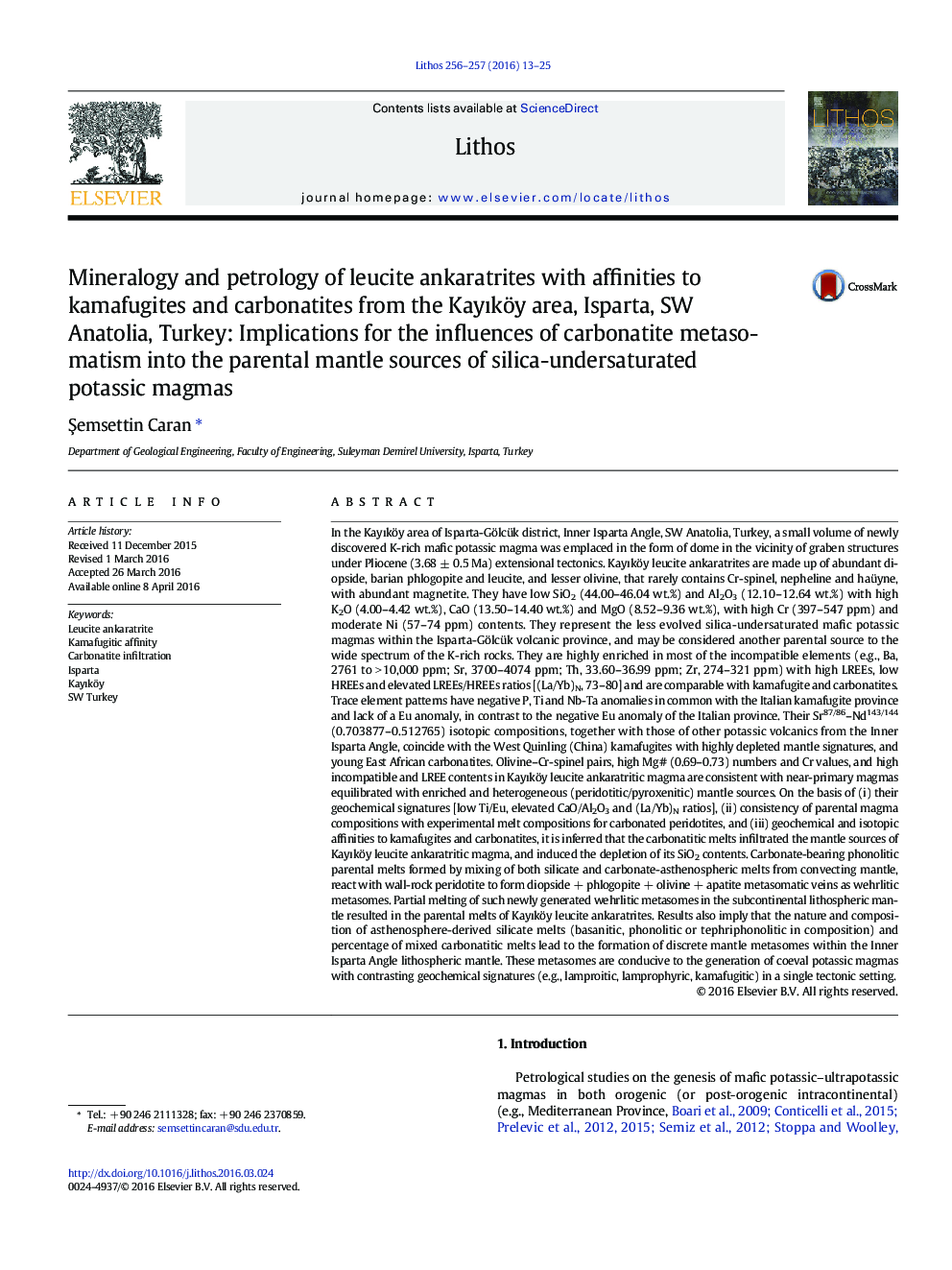| کد مقاله | کد نشریه | سال انتشار | مقاله انگلیسی | نسخه تمام متن |
|---|---|---|---|---|
| 4715485 | 1638646 | 2016 | 13 صفحه PDF | دانلود رایگان |

• The range of coeval potassic magmatism in the Isparta Angle, SW Turkey is a natural laboratory to elucidate the mantle beneath the region.
• The Kayıköy leucite-ankaratrites represent most silica-deficient mafic potassic lavas within the Inner Isparta Angle volcanic province.
• The major, trace element and isotope compositions of the Kayıköy leucite-ankaratrites show affinities to kamafugites and carbonatites.
• Mixing of both carbonate and silicate melts from asthenosphere produced carbonated phonolitic melts.
• The carbonate-bearing phonolitic melts react with peridotitic wall rock to produce wherlitic metasomes.
• The leucite-ankaratrites are derived from partial melting of the wherlitic mantle metasomes.
In the Kayıköy area of Isparta-Gölcük district, Inner Isparta Angle, SW Anatolia, Turkey, a small volume of newly discovered K-rich mafic potassic magma was emplaced in the form of dome in the vicinity of graben structures under Pliocene (3.68 ± 0.5 Ma) extensional tectonics. Kayıköy leucite ankaratrites are made up of abundant diopside, barian phlogopite and leucite, and lesser olivine, that rarely contains Cr-spinel, nepheline and haüyne, with abundant magnetite. They have low SiO2 (44.00–46.04 wt.%) and Al2O3 (12.10–12.64 wt.%) with high K2O (4.00–4.42 wt.%), CaO (13.50–14.40 wt.%) and MgO (8.52–9.36 wt.%), with high Cr (397–547 ppm) and moderate Ni (57–74 ppm) contents. They represent the less evolved silica-undersaturated mafic potassic magmas within the Isparta-Gölcük volcanic province, and may be considered another parental source to the wide spectrum of the K-rich rocks. They are highly enriched in most of the incompatible elements (e.g., Ba, 2761 to > 10,000 ppm; Sr, 3700–4074 ppm; Th, 33.60–36.99 ppm; Zr, 274–321 ppm) with high LREEs, low HREEs and elevated LREEs/HREEs ratios [(La/Yb)N, 73–80] and are comparable with kamafugite and carbonatites. Trace element patterns have negative P, Ti and Nb-Ta anomalies in common with the Italian kamafugite province and lack of a Eu anomaly, in contrast to the negative Eu anomaly of the Italian province. Their Sr87/86–Nd143/144 (0.703877–0.512765) isotopic compositions, together with those of other potassic volcanics from the Inner Isparta Angle, coincide with the West Quinling (China) kamafugites with highly depleted mantle signatures, and young East African carbonatites. Olivine–Cr-spinel pairs, high Mg# (0.69–0.73) numbers and Cr values, and high incompatible and LREE contents in Kayıköy leucite ankaratritic magma are consistent with near-primary magmas equilibrated with enriched and heterogeneous (peridotitic/pyroxenitic) mantle sources. On the basis of (i) their geochemical signatures [low Ti/Eu, elevated CaO/Al2O3 and (La/Yb)N ratios], (ii) consistency of parental magma compositions with experimental melt compositions for carbonated peridotites, and (iii) geochemical and isotopic affinities to kamafugites and carbonatites, it is inferred that the carbonatitic melts infiltrated the mantle sources of Kayıköy leucite ankaratritic magma, and induced the depletion of its SiO2 contents. Carbonate-bearing phonolitic parental melts formed by mixing of both silicate and carbonate-asthenospheric melts from convecting mantle, react with wall-rock peridotite to form diopside + phlogopite + olivine + apatite metasomatic veins as wehrlitic metasomes. Partial melting of such newly generated wehrlitic metasomes in the subcontinental lithospheric mantle resulted in the parental melts of Kayıköy leucite ankaratrites. Results also imply that the nature and composition of asthenosphere-derived silicate melts (basanitic, phonolitic or tephriphonolitic in composition) and percentage of mixed carbonatitic melts lead to the formation of discrete mantle metasomes within the Inner Isparta Angle lithospheric mantle. These metasomes are conducive to the generation of coeval potassic magmas with contrasting geochemical signatures (e.g., lamproitic, lamprophyric, kamafugitic) in a single tectonic setting.
Journal: Lithos - Volumes 256–257, July 2016, Pages 13–25